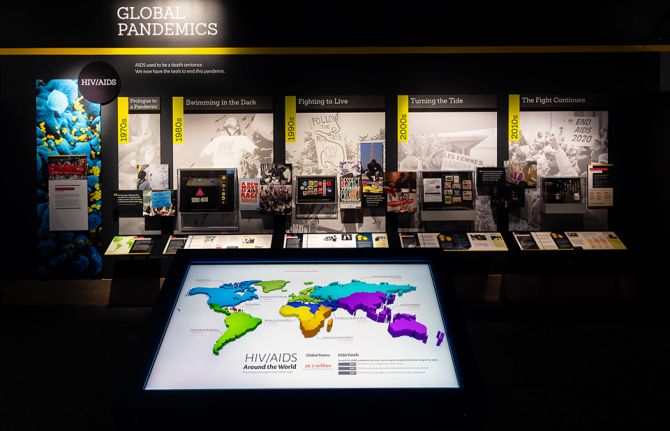



Feature Story
Smithsonian exhibition features UNAIDS data in a look at various viruses
21 August 2018
21 August 2018 21 August 2018An infectious disease can spread around the world in days. Human factors that have quickened the pace of virus transmission include the growing global population, urbanization and the industrialization of food production. The Smithsonian’s National Museum of Natural History in the United States of America features nine diseases that have spilled over from animals to humans in its newly opened exhibition, Outbreak: Epidemics in a Connected World.
One hundred years after the influenza pandemic, the three-year-long exhibition sheds a light on the causes of disease outbreaks such as Nipah virus and severe acute respiratory syndrome (SARS) and the various responses to epidemics.
“The 2014 Ebola outbreak in western Africa was the catalyst, but we wanted to have HIV—the pandemic of our time—as a big focus of the exhibition,” said Sabrina Sholts, the lead curator. For HIV, the museum created a three-dimensional timeline showing the landmarks of the AIDS response in the United States, from the activism to the science to the policy changes and treatment. Objects such as red ribbon pins, ACT UP T-shirts with a pink triangle with the saying Silence=Death, condoms, antiretroviral medicine bottles and photos guide visitors from the start of the HIV epidemic until now. A large touch table allows for people to explore new infections around the world today based on the latest UNAIDS data.
“We didn’t want to leave the impression that AIDS is over and limited to one place, so the interactive component resonates with people as to where we stand right now,” said Ms Sholts.
The UNAIDS Strategic Information Department worked with Ms Sholts’ team and provided specific epidemiological data. Timely and accurate data on diseases are the clues to trends in an epidemic. Displaying and using those data are critical pieces of our work,” senior UNAIDS epidemiologist Mary Mahy said.
Ms Sholts admits that making the data visually engaging was a challenge, but by simplifying the language and adding context, the digital interactive centerpiece works well.
The curator’s aim was to have visitors understand the varying difficulties of getting people to know their HIV status and ultimately the long-term benefits that that entails.
“Diseases are scary stuff, so for every dire challenge or obstacle, we created an “on the upside” component to highlight a success story or uplifting angle,” she said. For the HIV pandemic, the upsides focus on various organizations serving people in need, like the Ponce de Leon Center in Georgia, United States.
She explained that the main goal of Outbreak is to raise public awareness about pandemic risks with the perspective that human, animal and environmental health are all connected as one.
The exhibition also showcases a mock-up of an Ebola treatment ward and a game, played on touch screens, that has visitors simulate a variety of roles—epidemiologist, wildlife biologist or community worker—to complete tasks as a team to end an outbreak.
Part of Outbreak focuses on the detective work involved in tracking down and containing diseases. Future viruses are inevitable, which is why understanding human influence on their emergence and development is key.
Touching wild animals, a lack of vaccination, unprotected sex and travelling when sick all contribute to a virus’ proliferation, linking distant and diverse populations to each other beyond their communities, countries and continents. The response to these diseases, therefore, must also involve everyone.
“We are all connected, we all matter and we have to think holistically, collaboratively and collectively,” Ms Sholts said.
For those not travelling to Washington, DC, the Smithsonian has a free pared-down version of the exhibition—including the UNAIDS interactive display—available for translation and customization worldwide.



